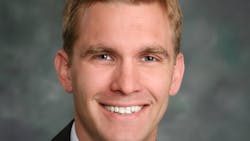During my nephew Frank’s recent visit with the “Virginia Levantos,” we heeded the call to actively recruit the next generation of aerospace professionals. My wife and I expanded the usual itinerary of D.C. stops to include an aviation maintenance technician school and a “discovery flight” from a local airport.
Frank is a good candidate; already committed to technical training, he is studying carpentry and planning a career in construction. We spent more than two hours at Reagan National Airport, touring the hangar, workshop and classrooms of the University of the District of Columbia’s maintenance training school. Instructor Ron Cruz described the typical student’s experience, showed off equipment and explained the rewarding careers available to successful graduates. Before we left, Ron turned on the virtual maintenance instruction simulator, digitally walking us through a Boeing cockpit, while describing the tests and checks performed by AMTs.
Frank was engaged throughout, asking questions and sharing experiences from his own hands-on learning. He sat in one of the school’s aircraft, debated whether he could fit through a hatch to check cabling, which no student would ever have to do … if they’ve properly mastered the correct techniques for testing tension, measured sheet metal thickness and watched a student proudly show off her composite materials project.
Two days later, we arrived at Potomac Airfield to meet up with Pilot Pete Castine. After talking us through a basic pre-flight, Pete ensured clearance for Washington’s highly-restricted airspace and loaded us for departure. With Frank advancing the throttle, we left Runway 6 and turned toward the practice area south of the city. An hour later, Frank had flown the aircraft, practiced basic turns, learned to read airspeed and altitude and could interpret the artificial horizon. He remained attentive through stall simulations and claimed to enjoy some unexpected “roller coaster” maneuvers.
“What do you think?” I asked while driving home. Frank knew what I meant. There was no secret about my motivation for the outings. “It was really cool,” he said, a description used no less than five separate times, without prompting, throughout his experience. “I still think construction’s for me, but planes could be a neat hobby.”
Recognizing why Frank didn’t immediately become interested in turning his talent to aviation is important. He, and thousands of other candidates, are not exposed to the possibilities in aerospace. His wood shop teacher is not pitching broad exploration for his talent, and guidance counselors and administrators aren’t equipped to direct students to our industry. Even after experiencing the “magic of flight” he still focused on how much roofers were getting paid to build developments off of Route 1 in Alexandria. Construction sites and careers are ubiquitous, “everyone” knows someone that works in that field.
When discussing my efforts to recruit Frank with the ARSA team, some great points came to light. Though he saw the “magic” in the aircraft, he did not translate the same qualities to a potential career. Youth tend to look for the obvious while aviation employers look for the elite: Regardless of what can be earned laying shingles or operating a construction crane, those tasks will never demand as much as a career designing, manufacturing, operating or maintaining an aircraft.
Recruitment may seem like a foot race or competition, but it doesn’t work that way in aviation. A 16-year-old may already think his or her future is all figured out, but life will provide numerous opportunities to create a real future. While a subcommittee of the Youth Access to American Jobs in Aviation Task Force established that most potential applicants are first exposed between ages 10 and 18, at that tender age, the aviation industry competes with countless other technical fields with easier entry points but far fewer career opportunities. Earlier is not always better, one of the miracles of aerospace is its ability to embrace knowledge and dedication from and by all age groups in its workforce. We know plenty of aviation professionals that started out in other fields, including construction.
My first-hand experience establishes something already known: our narrative must present aviation as part of exciting career journey. Learning to work with your hands, becoming knowledgeable in structure, fasteners, weight and balance on a residential or commercial roof or in the aviation school aren’t just job skills, they represent opportunities for future growth in a dynamic industry with multiple choices for a rewarding career. Our potential candidates must see the sky as the limit, not a roof, whether at 18 or 80.
Brett Levanto is vice president of operations of Obadal, Filler, MacLeod & Klein, P.L.C. managing firm and client communications in conjunction with regulatory and legislative policy initiatives. He provides strategic and logistical support for the Aeronautical Repair Station Association.About the Author
Brett Levanto
Brett Levanto is vice president of operations of Obadal, Filler, MacLeod & Klein, P.L.C. managing firm and client communications in conjunction with regulatory and legislative policy initiatives. He provides strategic and logistical support for the Aeronautical Repair Station Association.

